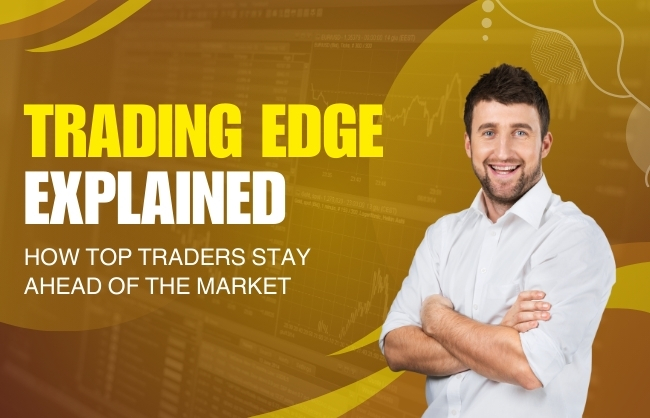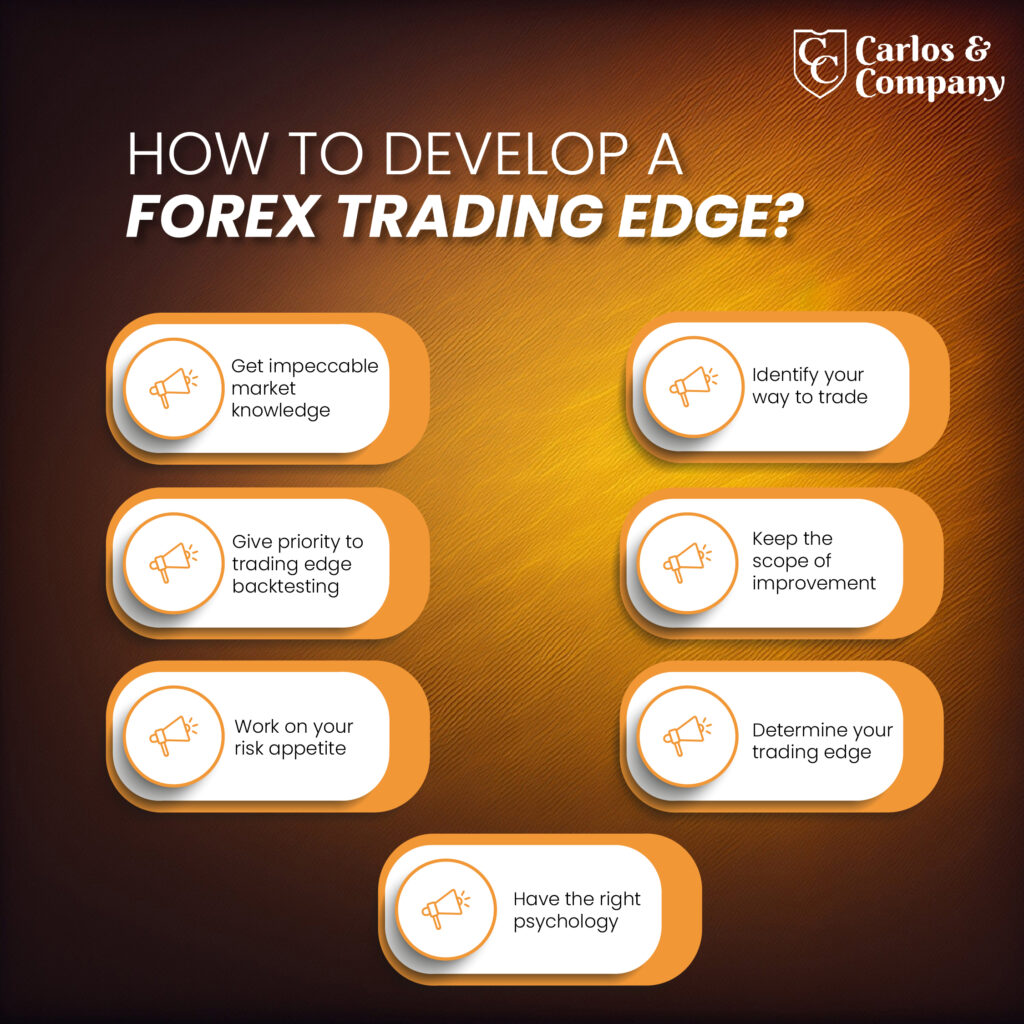Build Your Forex Trading Edge: The Secret Ingredient to Profitability
In the present time, forex trading edge is getting all the hype in the financial market. Many financial influencers and mentors talk about the edge. But only a few actually understand its true meaning.
No doubt, finding an edge in forex trading is crucial. However, before that, having a clear understanding of its concept is a must. In order to help you out, in this blog, we will discuss edge meaning in forex trading with examples and the process for developing it.
What is a Forex Trading Edge?
An edge can be defined as an approach, methodology or tool that refines your forex trading strategy in such a way that ultimately increases your winning rate.
Every trader has a different forex trading edge that is developed considering the fundamental, technical, psychological, and many other factors. It helps them to stand out in the crowd and achieve more profit than losses.

Traders with a forex trading edge can consistently make money in the forex market even when others are failing. Although having an edge is not necessary for forex trading, it’s a must for making a good profit.
Here's a quick look at what you'll read
A forex trading edge can be defined as an approach, methodology or tool that refines your forex strategy in such a way that ultimately increases your winning rate.
Having an edge is not necessary for forex trading, but for making a good profit, it’s a must.
- Get impeccable market knowledge
- Identify your way to trade
- Give priority to backtesting
- Work on your risk appetite
- Have the right psychology
- Keep the scope of improvement
- Determine your trading edge
Edge Ratio = Average Gain Per Trade / Average Loss Per Trade
You can calculate the authenticity by dividing the profit per trade by the loss per trade. An edge ratio of below one is considered poor, while above one is considered good for traders.
A forex trading strategy is a road map or blueprint that deals with when, what, where, how, and why. Meanwhile, a forex trading edge acts like a USP for a trader. Under this, traders improvise the style considering their strengths.
Forex Trading Edge Example
The concept of edge is quite complex to understand. Thus, let us look at some examples to get a clear picture:
Suppose a day trader trades EUR/USD. The person has been trading in the currency market for a while and is well-informed about the pair.
Let us take another example, suppose a trader understands the impacts of news on currency pairs well. So the person keeps an eye on specific news and data releases.
And stays prepared to take a position as soon as the news released. In this case, the traders have already planned the trade, while the others just know basic information and will plan it after the release.
The traders have identified a time frame in which the pair saw strong movement in a day and traded during that particular period based on a set of rules. Now, that can be seen as a forex trading edge.

How to develop a forex trading edge
If you want to develop a profitable forex trading edge strategy, we are here to help you. Follow the steps below and build a solid edge that can pave your way to profitability in forex trading:
Get impeccable forex market knowledge:
Learning is the most important step, regardless of trading with an edge or withoutan edge. However, when you want to develop, learning the basics of the forex market is not enough.
Developing a forex trading edge means building a system that will help you stay profitable even in the worst market conditions. And it will happen only when you know what others don’t know.
In this stage, with bookish or basic knowledge, identify the hidden market aspects. Select your specific trading instruments and get an in-depth understanding of them.
Analyse how it reacts to different technical, sentimental, and fundamental events. Further, learn to use advanced forex trading tools, robot advisors, and forex trading systems to enhance your trade.
Identify your way to trade
Generally, traders select a forex trading strategy like day trading, scalping, swing, position trading, or any other and start trading in the forex market.
However, that’s not the way. Once you have selected the trading strategy, you need to set your own criteria. For example, not all day traders follow the same plan; they have different approaches.
So, at this stage, identify your specific currency pairs, time frame, number of trades, news or patterns to trade, risk, analysis methods, and other parameters.
Give priority to forex trading edge backtesting
Backtesting is the key pillar for building a solid forex market edge. Once you have developed your plan, it’s time to test its authenticity.
A trader can backtest a forex trading strategy in many ways. First, open a forex demo trading account, place a number of trades, and analyze the wins and losses. Second, numerous automated backtesting software is available for free; you can seek the help of these tools.
And finally, you can backtest your strategy in a live forex trading account. Real accounts mean real market conditions and real profit or loss. So, start with small capital and backtest your forex trade effectively.
Work on your forex trading risk appetite
Many people feel that trading profit depends on luck. However, the fact is that it depends on how effectively you manage forex market risk. Risk-taking is essential for making money in the forex market.
However, it doesn’t mean you will take aggressive risks. If you want to survive in the forex market for a long time, then managing your risk is necessary. In this step, try different risk-to-reward ratios, set risk per trade, identify risk percentage, and embrace position sizing to limit losses.
Also, leverage can significantly impact and enhance your risk. So avoid trading with highly unrealistic leverages and test a variety of ratios for effective results.
Have the right forex trading psychology
For some traders, psychology is the real forex edge. Your mindset and how you control emotions are crucial in forex trading.
Your way of dealing with unfavorable market conditions can make you different from other traders. Most experienced traders fail to keep their trades unaffected by emotions. Many traders change their strategy frequently, place highly risky trades, blow trading accounts, and make the worst decisions just because of emotions.
Patience, discipline, consistency, rule-following, continuous learning and improvement are the components of building a psychological forex trading edge. Analyze how your emotions impact the trade and work on it.
Keep the scope of improvement
A forex trading edge cannot be permanent. Some are effective for a short period, while some are for a long period. However, how will you determine when your edge stopped producing results?
Thus, you need to keep track of all your forex trades for that purpose. You can seek the help of a forex trading journal. Prepare a journal, collect trade data, and regularly analyze it. Further, identify mistakes and optimize your edge accordingly.
Determine your forex trading edge
Many traders claim to have a trading edge, but the reality is different. However, you can calculate your edge with the below-mentioned formula and find out its effectiveness:
Edge Ratio = Average Gain Per Trade / Average Loss Per Trade Average Gain per Trade = Total Profit / Total winning trades. Average Loss per Trade = Total Loss / Total Losing Trades
Suppose the average gain per trade is $10, and the loss per trade is $6. So, the expectancy will be 1.6. So, we can say that your forex trading edge is giving you decent results.
An edge ratio of below one is considered low, while above one is considered high for traders. Also, calculate your edge ratio periodically so that you can work on it whenever your forex trading edge expectancy shows a decrease.
Forex Trading Edge vs Forex Trading Strategy: What’s the Difference?
Many traders confuse Forex Trading Edge with forex strategy and think that having a strategy means having an edge. However, these two forex terminologies are very different.
A forex trading strategy is a road map or blueprint that deals with when, what, where, how, and why. It defines the way to buy or sell a financial asset to achieve the desired profit. A plan can guide you at every stage of your trading journey. And almost every trader has a plan.
Meanwhile, a forex trading edge acts like a USP for a trader. Under this, traders improvise their style, considering their strengths, and trade under the forex market conditions that best suit them. They do this so that their profit is always greater than their loss. A trader with a forex trading edge gets better results than a trader without an edge. Generally, professional and advanced traders have an edge.
Bottom Line
Forex trading edge comes from experience, knowledge, and understanding. Build your edge by considering risk, psychology, analysis, time frame, profit expectancy, and forex trading instruments.
Also, once you feel you have a forex trading edge, test it, find out the edge ratio and analyze whether it’s working for you or not. Further, continuous analysis and improvement are necessary for consistent profitability.
Struggling in Developing a Forex Trading Edge?
Carlos and Company can help you with that. Our research teams help traders in developing top-notch strategies and an edge by understanding their needs.
Let Market Professional Makes Your Trading Journey Professional. Start Your Demo Trial Today.
